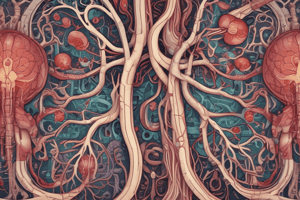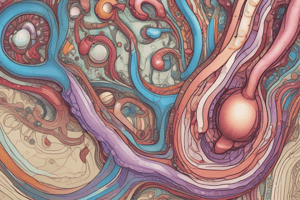Podcast
Questions and Answers
What is the primary function of the proximal tubule in the nephron?
What is the primary function of the proximal tubule in the nephron?
- Reabsorption of glucose and salts (correct)
- Concentration of urine
- Secretion of hydrogen ions
- Filtration of blood plasma
Which structure is located in the cortex of the kidney?
Which structure is located in the cortex of the kidney?
- Proximal tubule (correct)
- Distal tubule (correct)
- Collecting duct
- Medulla
In which part of the nephron does the secretion of hydrogen ions primarily occur?
In which part of the nephron does the secretion of hydrogen ions primarily occur?
- Loop of Henle
- Distal tubule (correct)
- Bowman's capsule
- Proximal tubule
What is the role of glomeruli in kidney function?
What is the role of glomeruli in kidney function?
Which ion is primarily involved in the secretion process occurring in the distal tubule?
Which ion is primarily involved in the secretion process occurring in the distal tubule?
Salts are primarily reabsorbed in which section of the nephron?
Salts are primarily reabsorbed in which section of the nephron?
What is the primary function of the nephron in the kidney?
What is the primary function of the nephron in the kidney?
Which of the following substances is NOT typically included in the glomerular filtrate?
Which of the following substances is NOT typically included in the glomerular filtrate?
What does the nephron filter on average per minute?
What does the nephron filter on average per minute?
Which component of the nephron is responsible for filtration of plasma?
Which component of the nephron is responsible for filtration of plasma?
Which statement is true regarding the selectivity of the nephron's filtration process?
Which statement is true regarding the selectivity of the nephron's filtration process?
How many nephrons does an average human kidney contain?
How many nephrons does an average human kidney contain?
What substances comprise the glomerular filtrate?
What substances comprise the glomerular filtrate?
Which of the following best describes the loop of Henle?
Which of the following best describes the loop of Henle?
What is the primary function of the proximal tubule in relation to sodium?
What is the primary function of the proximal tubule in relation to sodium?
Which of the following correctly describes the role of the descending loop of Henle?
Which of the following correctly describes the role of the descending loop of Henle?
What is the threshold level for glucose reabsorption in the proximal tubule?
What is the threshold level for glucose reabsorption in the proximal tubule?
What is the main function of the distal and collecting tubules?
What is the main function of the distal and collecting tubules?
What condition is indicated by polyuria?
What condition is indicated by polyuria?
During which phase does the ascending loop of Henle reabsorb solutes without reabsorbing any water?
During which phase does the ascending loop of Henle reabsorb solutes without reabsorbing any water?
Which substances are primarily reabsorbed by the proximal tubule?
Which substances are primarily reabsorbed by the proximal tubule?
What effect do diuretics have on urine volume?
What effect do diuretics have on urine volume?
Flashcards are hidden until you start studying
Study Notes
Renal Physiology
- Nephron is the major functional unit of the kidney, with approximately 1 million nephrons per kidney.
- Composed of glomerulus and renal tubules, and acts as a non-selective filter for plasma substances under 70,000 MW.
- Glomerular filtrate includes water, glucose, electrolytes, amino acids, urea, uric acid, creatinine, and ammonia.
- Filters approximately 120 ml/min, which is about one-fifth of renal plasma.
Nephron Structure and Function
- Glomerulus: A coil of capillary vessels where filtration occurs.
- Proximal Tubule:
- Reabsorbs water, sodium chloride, bicarbonate, potassium, calcium, amino acids, phosphates, protein, and glucose.
- Glucose threshold for reabsorption is 160-180 mg/dL.
- Secretes sulfates, glucuronides, hydrogen ions, and drugs.
- Loop of Henle:
- Descending limb: Reabsorbs water; solutes are not reabsorbed.
- Ascending limb: Reabsorbs solutes (sodium, chloride, calcium, magnesium); water is not reabsorbed.
- Distal and Collecting Tubules:
- Reabsorbs sodium and secretes potassium, ammonia, and hydrogen ions, with potassium ions exchanged for sodium ions.
Urine Volume
- Normal Volume: Average of 1200-1500 ml/day.
- Polyuria: Exceeds 2500 ml/day; can be caused by diabetes insipidus, diabetes mellitus, use of diuretics, caffeine, alcohol, or excessive water intake.
- Oliguria: Defined but specific causes not provided in the text.
Studying That Suits You
Use AI to generate personalized quizzes and flashcards to suit your learning preferences.




